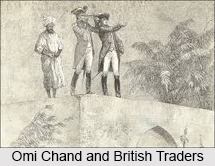 Omichund or Amir Chand was a native man from Murshidabad, now located in Murshidabad District of West Bengal. He was settled in Murshidabad. His house presently is in dilapidated condition, now a popular tourist attraction in Murshidabad.
Omichund or Amir Chand was a native man from Murshidabad, now located in Murshidabad District of West Bengal. He was settled in Murshidabad. His house presently is in dilapidated condition, now a popular tourist attraction in Murshidabad.
Contribution of Omichund
The name Omichund or Amir Chand is associated with the treaty negotiated by Robert Clive and the independent Nawab of Bengal, Siraj ud Daullah before the Battle of Plassey in 1757.
Residence of Omichund
It is impossible now to unravel the intrigues in which he may have engaged, but some facts about his career can be stated. He had long been resident at Kolkata, where he had acquired a large fortune by providing the investment for the British East India Company, and also by acting as intermediary between the English and the native court at Murshidabad. His house in Kolkata is still now not known. In a letter of Mr. Watts of later date, Omichund is represented as saying to the Nawab of Bengal, Siraj ud Daullah and also an intermediate person of British East India Company.
He had lived under the English protection these forty years; that he never knew them once to break their agreement, to the truth of which he took his oath, by touching a Brahman`s foot; and that if a lie could be proved in England upon anyone, they were spit upon and never trusted.
Houses of Omi Chand in Kolkata
There are several houses owned by him in Calcutta (now Kolkata) are mentioned in connection with the fighting that preceded the tragedy of the Black Hole in 1756, and it is on record that he suffered heavy financial losses at that time. He had been arrested by the British East India Company on suspicion of treachery, but afterwards he was forward in extending help to the fugitives and also valuable advice.
Role of Omichand for the Decline of Siraj
Omichund or Amir Chand was sent by Robert Clive to accompany Mr. Watts as agent at Murshidabad. It seems to have been through his influence that the Nawab gave reluctant consent to Clive`s attack on Chandernagore. Later, when the treaty with Mir Jafar was being negotiated 1757, he put in a claim for 5% on all the treasure to be recovered, under threat of disclosing the plot. To defeat him, two copies of the treaty were drawn up: the one, the true treaty, omitting his claim; the other containing it, to be shown to him, which Admiral Watson refused to sign, but Robert Clive directed the admiral`s signature to be appended. When the truth was revealed to Omichund after Battle of Plassey, Macaulay states that he sank gradually into idiocy, languished a few months, and then purportedly died. However, as a matter of fact, he survived for ten years, until 1767; and by his will he bequeathed 2000 to the Foundling Hospital (where his name may be seen in the list of benefactors as a black merchant of Kolkata, and also to the Magdalen Hospital in London. Later Robert Clive testified and defended himself thus before the House of Commons of Parliament on May 10, 1773, during the Parliamentary inquiry into his conduct in India.
Related Articles
History of Kolkata
Medieval History of Kolkata
Murshidabad District
Visiting Places in Murshidabad
Monuments in Murshidabad
Architecture Under the Nawabs of Murshidabad
Mir Jafar
British East India Company
Hazarduari Palace
Tourism in Murshidabad



















